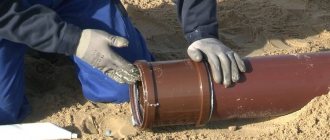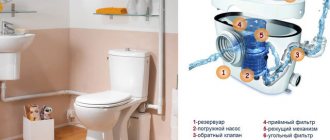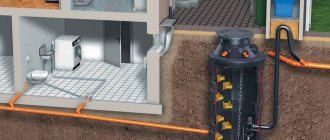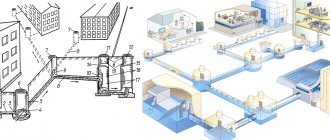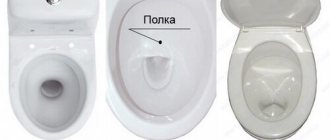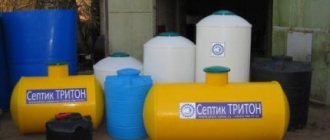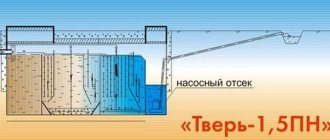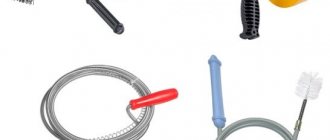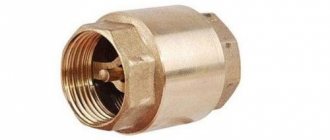The arrangement of apartments and houses with a drainage system is considered an important process not only from the point of view of functionality, but also a factor that determines the possibility of free planning of premises. The drainage system is designed in such a way that wastewater must be discharged by gravity.
The configuration and dimensions of such systems make it difficult to place furniture and plumbing due to their connection to the outlet communication. In addition, problems arise when finding a place to install household appliances (filters, washing machines and dishwashers). A sewage pump, which has a compact body made of polymer or metal, will help solve them. It can be easily installed under the sink in the kitchen or bathroom.
Types of fecal devices
All sewage pumps are divided into several categories based on their technical characteristics. So, based on their design features, they are divided into the following groups:
- drainage type (pumps clean and slightly contaminated water);
- fecal type (pumping out feces, sewage, and highly contaminated water);
- sewerage pumping stations (discharge sewage in automatic mode).
Any fecal device is equipped with level sensors, and therefore they are divided into:
- pumps with float switch. This type is equipped with a simple electric key, the work of which is to close or open the system. It all depends on the position of the float;
- pumps with touch sensor. They are a two-sensor device, where one sensor is located at the base of the pump, the other in the area of the top cover. This system is very simple. As soon as the liquid exceeds the upper sensor level, the upper sensor is triggered and the engine starts. As soon as the liquid reaches the lower level of the sensor, the lower sensor turns off the motor.
Sewage pumps are further divided into the following types:
- submersible and semi-submersible plan;
- external plan, which are adapted for pumping cold liquids;
- external plan, which are able to pump hot wastewater with a maximum temperature of up to 90 degrees.
There is also another division of pumps into the following subtypes:
- by distinction related to appointment;
- differ in characteristics (power, productivity, pressure);
- can be mobile or stationary;
- oil or water engine cooling system;
- with horizontal or vertical connection method.
Features of the installation of SPS
Considering the seriousness of the operation of such equipment and the high safety requirements, it is worth entrusting the installation of the pumping station to professionals.
1.
- Before installation, select a location for the tank in accordance with GOST standards.
- To install a sewage pumping station, trenches for pipes and a pit for the tank are prepared. The level of the pipes and the depth of the hole depend on the characteristics of the soil. The company’s specialists analyze the soil and determine the permissible depth for laying communications.
- Butt joints must be airtight.
- The body and pipes must be made of durable, environmentally friendly material.
Specialists will select the optimal system design and determine the installation location in accordance with the standards of the current GOST. Our technicians ensure complete sealing of the system, adjustment of all modules, and connection to the network. Before delivery of the system to the customer, a test run is carried out. The client is taught the rules for managing the pumping station and is provided with technical support for the work of the pumping station.
Purpose of sewage pumps
Fecal pumps are manufactured to perform the following functions:
- they are installed in rooms whose level is below the sewer drain (in basements, basements);
- you can connect several household appliances to them at once;
- facilitates rearrangement of the sink;
- prevents sewer pipes from becoming clogged, and therefore there is no possibility of plugging.
How do sewer pumps work?
The operating principle is quite simple. The drain liquid, together with waste products, enters the tank. As soon as the amount of this liquid reaches a set level, a mechanism for forced pumping is activated using a float. The shredder is immediately activated, thanks to which large pieces of waste are crushed.
It is worth noting that the operation of the sewage pump prevents the appearance of unpleasant odors in the room. This is due to the fact that the pump is equipped with a sealed housing, a check valve and a carbon filter.
The system does not require additional maintenance. You just need to flush the tank regularly. There are some nuances that are associated with the operation of pumps. Due to the fact that such devices operate from the network, they require uninterrupted power supply. Otherwise, their operation is not possible.
Criterias of choice
Technical characteristics of the submersible pump
First of all, sewage pumps are selected based on what tasks will need to be solved using such equipment. If the fraction size is no more than 50 mm, a submersible drainage pump will be sufficient. In situations where it is necessary to organize the outflow of sewage from the toilet (the size of the fractions will be more than 50 mm), it is permissible to use only a fecal pump. In addition to this criterion, a number of other parameters should be taken into account when choosing:
- Power. This characteristic must be considered in conjunction with the level of performance. Sometimes a less powerful model functions just as efficiently as a higher power unit. In this case, it is recommended to choose the first option, which allows you to save energy. In addition, there must be a power reserve (up to 30%), which will avoid the risk of overloads and equipment shutdowns.
- Type of materials from which the pump body is made. The duration of operation of the equipment will depend on this parameter, because if a submersible version is selected, the mechanism will be constantly in contact with aggressive environments. Therefore, it is important to purchase a design that is sufficiently resistant to corrosion. The preferred option is a housing made of cast iron, steel and plastic. In addition, it is necessary to check the presence of sealing elements.
- The structure of the chopper. In order to obtain equipment with a high degree of efficiency, it is advisable to pay attention to the design of the impeller. The fact is that the knife installed on this unit has a higher level of performance than the cutting edge (sharpened edges of the impeller). In addition, the self-cleaning function of the grinding mechanism will not hurt. This increases the service life of such equipment.
- Easy to operate, allowing you to apply a minimum of effort when operating the equipment. Preferred are models equipped with an automation unit. There is no need to specifically turn on the pump, since it starts when a certain level of wastewater is reached.
In addition, the following factors should be taken into account:
- what period of time the mechanism will operate;
- to what depth it will be immersed;
- is there a shredder;
- at what distance from the drainage point will the unit be located;
- liquid temperature;
- performance;
- the diameter of the pipe through which water will be pumped out;
- possible sizes of solid impurities.
In addition to the fact that it is important to take into account the basic parameters of sewage pumps, it is also advisable to carry out the installation correctly, as this is an additional guarantee of correct and efficient operation. To achieve this goal, it is recommended to entrust the installation of sewage pumping equipment to professionals. When it comes to choosing a manufacturer, Grundfos occupies a leading position. A large number of pumps for pumping out wastewater are produced under this brand.
Advantages and disadvantages of sewerage stations
Sewage stations have the following advantages:
- low noise level;
- versatility;
- compactness;
- ease of installation and subsequent maintenance;
- fairly good external data.
Such stations can be used for quite a long time thanks to the chopper. This device helps to make not only feces very small, but also other items that enter the system: toilet paper, hygiene products. There is an opinion that it is almost impossible to clog such a system.
Today, manufacturing companies produce two types of sewage pumps: special and for general use. Special ones are installed for certain places, such as the kitchen and toilet, then the two points are connected together and a pump is installed there to discharge the wastewater. The second type is used wherever it is necessary to pump out sewage and wastewater.
Sololift
In general, this name for pumping systems for sewerage from the German company Grundfos has become a household name. And the entire line of its wastewater pumps, taking into account many years of operation and the problems that arose during it, has reached the second generation and is represented by 5 models.
Grundfos Sololift 2:
- WC-1 today can be bought from the official representative of the company in Russia for 18 thousand rubles, it pumps wastewater from the toilet and sink, and has a mechanism for grinding solid particles;
- WC-3 with a cost of 22.4 thousand rubles. differs from WC-1 in the presence of an additional inlet pipe for connecting another device (shower stall, bidet or urinal);
- CWC-3 for 400 rub. more expensive than WC-3, it is designed for front wall mounting;
- C-3 with a cost of 19 thousand 950 rubles. pumps so-called gray waste (without fecal matter) with temperatures up to 75°C and can withstand temperatures of 90°C for up to half an hour, does not have a cutting mechanism;
- D-2 is the simplest and most inexpensive station (15 thousand 100 rubles), pumping gray wastewater from a shower stall, bidet or washing machine.
To be fair, it is worth noting that before the inlet pipe, a branch can be made to supply another device, preferably not used simultaneously with the already connected equipment.
On the Russian market, in addition to Grudfos sololifts, there are devices from the Italian company Broisan, with almost the same set of functions, with slightly better performance in lifting liquids (up to 8 m versus 6 m), but also at a higher price - up to 29 thousand rubles. at the leader of the line.
We also have at our disposal another Italian Calpeda GEOCOMP with a 5-meter lift and a cost of 17.6 thousand rubles. Other models and companies are almost never found on our market, and therefore do not have repair facilities or even any clear reviews of their work.
The principle of operation of the station with a grinder of solid fecal waste, and it allows not only the presence of paper in the toilet, but also, according to manufacturers, some hygiene products, is quite simple. I’ll show it using the Broisan pump as an example.
Installation options may be different, but the appropriate models must be selected.
It is possible to install several stations, but in this case it is worth thinking about a second method of drainage.
Pros and cons of sewage pumps
Basically, these devices have only positive qualities, namely:
- high performance at an affordable price (a unique combination of price and quality);
- models are equipped with a filter that prevents solid particles from entering directly into the pump, thereby protecting it;
- can work both with full and partial immersion;
- small size, low noise level;
- Installs quickly and easily.
The only drawback is considered to be that this type of pump can lift water from a depth not exceeding 10 meters. It is also not recommended to install it in close proximity to a silty or sandy bottom.
Brief overview of manufacturers
When choosing a fecal pump, it is better to give preference to models from well-known manufacturers. They specialize in this type of equipment, so their technology is always on top. And even in case of breakdowns, parts for repairing such pumps are always much easier to find.
Among the variety of brands suitable for use in the country:
- Pedrollo Vortex – “VXm” series with low power (Italy).
- Gilex – “Fekalnik” series (Russia).
- SFA – compact grinder pumps for home use (France).
- Grundfos (Denmark).
- Marina-Speroni (Italy).
- Calpeda (Italy).
- Whirlwind (Russia).
- Belamos (Russia).
It is worth saying that Russian pumps are in no way inferior to their imported counterparts. They were initially developed for domestic realities with voltage drops, etc.
Borehole pumps, their advantages and disadvantages
- The positive points include:
- they have a small diameter, which makes it possible to use it for pumping water from narrow wells;
- able to lift water from a depth of 50 meters;
- will work well near sandy, muddy or calcareous bottoms;
- it is perfectly protected from overheating and power surges;
- copies are produced that can be installed in a horizontal position.
There is one significant drawback. These categories of pumps are very difficult to repair. In order to troubleshoot a device, you must first remove it, repair it, and then install it again. But, despite this, the pump is able to operate without failure for quite a long time and its performance is very high.
We remove wastewater from the basement or basement
It is this task of forced removal of household sewage in individual construction that has to be solved more often, but there are much more options for solving it. There are more technologically advanced ones, but more expensive, and there are others that are not at all complex and inexpensive to implement.
The first is the installation of a sololift suitable for the parameters with a rise to a given height and output to a gravity system that ensures drainage from rooms located above ground level.
The second is the installation of a container for collecting liquid sewage and pumping it directly into a septic tank (cesspool) or, as in the previous version, into the gravity drainage system of the house.
Let's take a closer look at both.
Scope of application of sewage pumps
Their scope of application is very diverse. Such devices are often found both in industrial enterprises and in the private sector. Thanks to them, dirty liquids containing solid particles are pumped. Household models are able to handle from 5 to 25 cubic meters/hour. Domestic installations are used mainly to pump out wastewater in a storm drain or an autonomous system, surface water from basements and basements, well water, and drain pools, ponds and natural reservoirs. But pumping water is not their only purpose. They can be used for large reservoirs to circulate water, as well as for irrigation of land.
Prices
Below is a small table with popular pump models and their costs.
| Model | Type | price, rub. |
| Jemix STP-100 | For forced sewerage | 10400 |
| CLEAN WG ESPA | 40400 | |
| Grundfos SEG | Submersible | 81762 |
| JILEX Fekalnik 255/11 N | 8200 | |
| WILO LPC 40/19 | Surface | 59000 |
| GARDENA 4000/5 | 12000 | |
| Grundfos MTH 2-60/6 | Semi-submersible | 30000 |
| Speroni GF 100 | 46515 |
We will learn how to choose sewer pipes in a private house from this article. All about autonomous sewerage in a cottage - details below.


